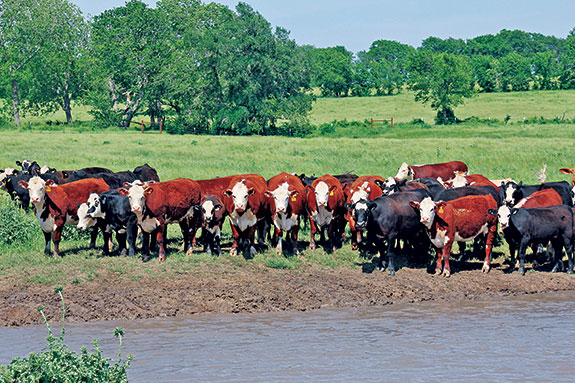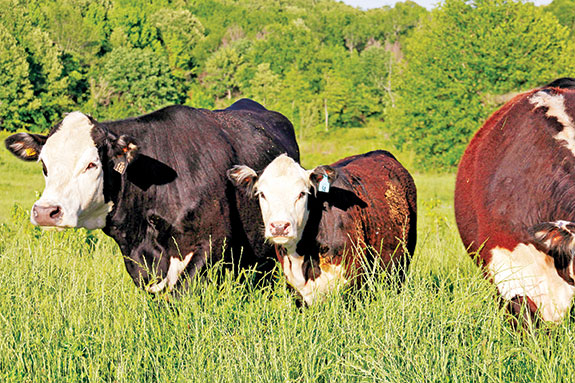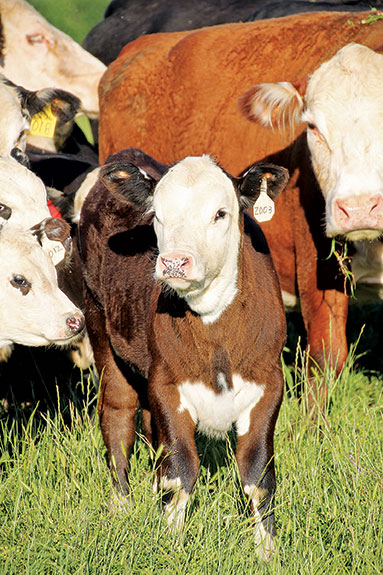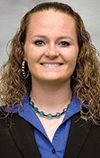Editor's note 6.13.13: This story is corrected from an earlier version that appeared in the June 2013 issue of Progressive Cattleman. Quotes that were attributed to Hereford America are now attributed to Bobby Lide. Progressive Cattleman regrets the error.
According to Bobby Lide of Triple L Black Hereford Ranch, located in Mexia, Texas, “Black Herefords are a hybrid breed developed by crossing Hereford and Angus cattle and having at least 62.5 percent registered Hereford blood, black in color and sired by a bull registered by the American Black Hereford Association.
Most have traditional white markings of a Hereford but are black-hided instead of red.”
Black Herefords usually take three generations to create. It starts with a traditional Hereford-Angus cross, which results in a Black Baldy.
That female is then bred back to a Black Hereford bull, and the resulting offspring can then be registered as a Black Hereford.
The American Black Hereford Association was established in 1994 in Lawrence, Kansas, by the late John Gage.
The first cattle to qualify were registered in 1997.
The Black Hereford became a registered trademark in 2002 and received international breed designation from the National Association of Animal Breeders in 2003.
In 2005, EPDs were established for the breed, and the Black Hereford Beef product line was created.

A popular quality
“The meat quality of Black Hereford beef cattle is superb,” Lide said. “Many cattle ranchers choose this breed specifically for this factor alone. But they display a number of exceptional qualities.”
He continued, “Black Herefords can withstand extremes in weather with seeming ease and are very efficient at using their food for weight gain, making them well-suited for grazing and grass-fed diets.”
A relatively new breed, the Black Hereford is growing in popularity. Triple L Black Hereford Ranch is a leader in the breed. The ranch is owned by Bobby and Jared Lide, as well as Bobby’s wife, Deanna.
The ranch was started in 2009. Bobby Lide was retired from his family’s storage-tank manufacturing business and wanted to expand his hobby of raising cattle.
He found the Black Hereford and decided that’s the breed he wanted to pursue.
“I have always raised commercial cattle and decided to start a registered herd.
As we searched for the perfect type cattle to raise, we found the Black Herefords were a new breed, very gentle and easy keepers.
Black Herefords are a mix between Black Angus and Herefords, so we figured that having this mix of cattle, it had to be good.
We traveled all over the U.S. looking for the best cattle we could find and finally put our herd together with cattle coming from many states,” he says.
They purchased a number of Black Hereford bulls and heifers from the J&N Annual Production Sale in 2010 and shortly after that purchased all of the stock from the Wild Rose Ranch in California.
In 2011, they purchased cattle from Iron Lake Ranch, and in 2012, purchased additional cattle from J&N.
“Triple L has a tremendous herd with top bulls and heifers and is becoming a strong leader in Black Hereford breeding,” said Lide. “We believe we have some of the best genetics in the breed.”

Traits to create a legacy
Those who own the Black Hereford breed see several advantages to the traditional commercial cow. “The American Black Hereford is bred for a number of outstanding attributes,” said Lide.
“First and possibly most important among these is fertility. In establishing the breed, bulls were even chosen for registration based upon the size of their testicles.
“Creating and refining a new cattle breed requires early and consistent generational progress.
“Heifers need to produce a calf at a young age and deliver that calf easily without complications.
“The Black Hereford does this very well.”
He continued, “Black Hereford heifers have wide pelvic bones that assure easy delivery.
Calves are born small and grow quickly. The Black Hereford’s natural ability to efficiently turn their food into weight gain assures heavy yearling weight.”
The heterosis that is offered can be hard to beat. “We have two excellent breeds together in one package,” Lide explained.
“Angus and Herefords together make quality beef and add pounds on the ground quickly. Commercial cattlemen like the fact that they can get black calves with the quality of Hereford-Angus all in one package, all at one time. With these qualities, we find that the steers grow quick, with less fat, better marbling, and heifers are perfect for replacement cattle considering black color and good milk.”

Building the numbers
The Black Hereford breed is still relatively small in numbers, with only 44 breeders across the U.S. as of the first of the year.
“The number of Black Herefords at this time, registered through the association, is approximately 4,000,” Lide said. “The numbers are growing and we have more and more cattle raisers getting interested in this new breed of cattle.”
This limited number is a challenge for Black Hereford breeders, however. “At this time the only challenge I see is the limited number of Black Herefords available.
“Triple L Ranch produces good-quality cattle, and we must stay with our plan to produce quality and not quantity,” Lide states.
Even with this challenge, Lide and his family enjoy the lifestyle of raising cattle and especially Black Herefords.
“With the cattle business, you must put all your talents to work every year. I like promoting the Black Hereford breed and marketing what we produce,” he said.
“A cattle raiser gets to work with genetics, agriculture, farming, accounting, feeding programs, intensive grazing and more.
With most of the things I mentioned, you have to wait at least a year or more to see if what you think will work, really works. There is something new happening with each and every season and almost daily. I enjoy everything about the cattle business.”
He added, “I suppose there is no other business that challenges all attributes of life at one time like cattle. Even with the challenges, it’s hard to beat a cool morning, watching the sun come up and seeing a newborn calf nurse for the first time.” ![]()
PHOTOS
Photo 1: A future Black Hereford herd sire.
Photo 2: Red Herefords and Black Herefords on a Texas pasture.
Photo 3: Black Herefords are a hybrid breed developed by crossing Hereford and Angus cattle and having at least 62.5 percent registered Hereford blood, black in color and sired by a bull registered by the American Black Hereford Association.
Photo 4: The Black Hereford breed offers a heterosis advantage to producers, and a premium for the black hide. A red Hereford cow bred to a homozygous Black Hereford bull produces a Black Hereford calf. Photos courtesy of American Black Hereford Association.







